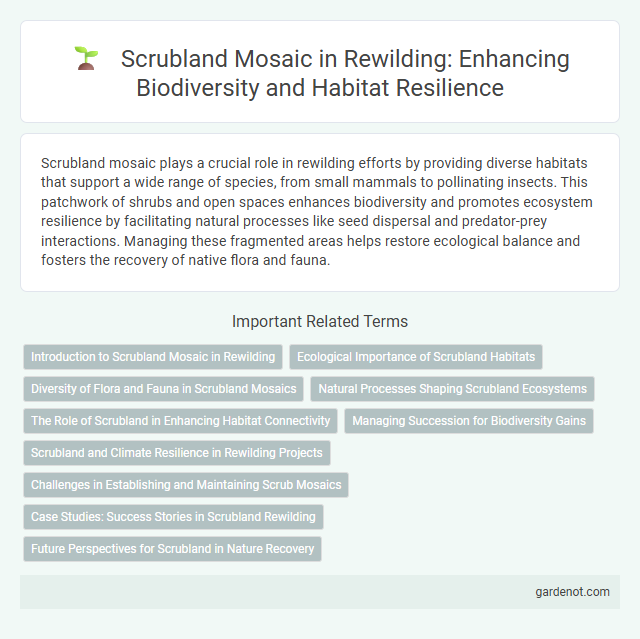Scrubland mosaic plays a crucial role in rewilding efforts by providing diverse habitats that support a wide range of species, from small mammals to pollinating insects. This patchwork of shrubs and open spaces enhances biodiversity and promotes ecosystem resilience by facilitating natural processes like seed dispersal and predator-prey interactions. Managing these fragmented areas helps restore ecological balance and fosters the recovery of native flora and fauna.
Introduction to Scrubland Mosaic in Rewilding
Scrubland mosaic habitats consist of a diverse interspersion of shrub patches, grasslands, and open spaces, fostering rich biodiversity and ecological resilience in rewilding projects. These mixed vegetation structures provide essential resources and shelter for wildlife, supporting species such as ground-nesting birds, pollinators, and small mammals. Integrating scrubland mosaics enhances landscape connectivity and promotes natural ecological processes crucial for habitat restoration and species recovery.
Ecological Importance of Scrubland Habitats
Scrubland habitats support high biodiversity by providing essential shelter and food resources for various bird species, mammals, and insects. These mosaic environments promote nutrient cycling and soil stabilization through diverse plant communities adapted to intermittent disturbance. Maintaining scrubland mosaics enhances resilience against climate change by serving as ecological corridors that facilitate species movement and genetic exchange.
Diversity of Flora and Fauna in Scrubland Mosaics
Scrubland mosaics support a rich diversity of flora including drought-resistant shrubs, wildflowers, and grasses that create varied microhabitats. This structural complexity sustains numerous fauna species, such as reptiles, small mammals, and insect pollinators vital for ecosystem functioning. The heterogeneity of plant life in scrubland mosaics enhances resilience against environmental stressors and promotes biodiversity conservation in rewilding projects.
Natural Processes Shaping Scrubland Ecosystems
Natural processes such as fire regimes, herbivory, and seed dispersal play a crucial role in shaping scrubland mosaic ecosystems by maintaining biodiversity and habitat heterogeneity. Disturbance dynamics promote the regeneration of native shrub species and prevent woody plant succession, sustaining ecological balance in scrublands. These processes support a mosaic of microhabitats that enhance resilience and facilitate species interactions within rewilded landscapes.
The Role of Scrubland in Enhancing Habitat Connectivity
Scrubland mosaic plays a critical role in enhancing habitat connectivity by serving as ecological corridors that facilitate wildlife movement and gene flow between fragmented habitats. The heterogeneous structure of scrubland provides diverse microhabitats that support various species, increasing overall biodiversity and resilience to environmental changes. Integrating scrubland into rewilding projects helps bridge isolated ecosystems, promoting ecological networks essential for species survival and ecosystem functionality.
Managing Succession for Biodiversity Gains
Managing succession in scrubland mosaics enhances biodiversity by maintaining a dynamic habitat structure that supports diverse plant and animal species. Strategic intervention such as controlled grazing, selective cutting, and periodic disturbance prevents scrubland from progressing to dense woodland, preserving open areas vital for pollinators, ground-nesting birds, and specialist invertebrates. These practices optimize ecological niches and promote species richness within rewilding projects focused on restoring natural processes.
Scrubland and Climate Resilience in Rewilding Projects
Scrubland ecosystems play a crucial role in enhancing climate resilience within rewilding projects by supporting biodiversity and stabilizing soil against erosion. The diverse vegetation structure in scrubland mosaics aids in carbon sequestration and provides habitats for a range of wildlife species, contributing to ecosystem recovery. Effective management of scrubland areas within rewilding initiatives helps buffer against extreme weather events and mitigates the impacts of climate change.
Challenges in Establishing and Maintaining Scrub Mosaics
Establishing and maintaining scrubland mosaics faces challenges such as invasive species encroachment, which disrupts native biodiversity and alters habitat structure. Managing fire regimes is complex yet critical, as inappropriate fire frequency or intensity can either degrade scrubland or promote undesirable woody plant dominance. Securing long-term funding and community support remains vital to implement adaptive management strategies that sustain the ecological and functional integrity of scrub mosaics.
Case Studies: Success Stories in Scrubland Rewilding
Case studies in scrubland rewilding demonstrate significant biodiversity recovery through targeted habitat restoration and species reintroduction in key sites such as the Iberian Peninsula and parts of Australia. Restoration efforts have led to increased populations of native fauna including the Iberian lynx and various bird species, enhancing ecosystem resilience and connectivity within scrubland mosaics. These success stories provide scalable models that optimize ecological functions while balancing human land use in Mediterranean and semi-arid environments.
Future Perspectives for Scrubland in Nature Recovery
Scrubland mosaic restoration plays a crucial role in enhancing biodiversity and ecosystem resilience within nature recovery initiatives. Future perspectives emphasize integrating adaptive management techniques to promote native flora regeneration and support diverse fauna habitats. Incorporating connectivity corridors will facilitate species movement and genetic exchange, strengthening overall landscape ecological integrity.
Scrubland mosaic Infographic

 gardenot.com
gardenot.com